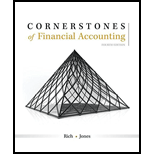
Concept explainers
Concept introduction:
Time value of money:
Time value of money is the concept that differentiates the value of money received today and the value of same money received in future. According to this concept, the same amount of money to be received in future shall have lower present value (value of the money today) due to the interest that could be earned on that money.
Requirement 1:
To calculate:
Balance in the account in 5 Years.
Concept introduction:
Time value of money:
Time value of money is the concept that differentiates the value of money received today and the value of same money received in future. According to this concept, the same amount of money to be received in future shall have lower present value (value of the money today) due to the interest that could be earned on that money.
Requirement 2:
To calculate:
How much interest we earned in 7 years?
Concept introduction:
Time value of money:
Time value of money is the concept that differentiates the value of money received today and the value of same money received in future. According to this concept, the same amount of money to be received in future shall have lower present value (value of the money today) due to the interest that could be earned on that money.
Requirement 3:
To calculate:
Calculate interest.
Trending nowThis is a popular solution!

Chapter A3 Solutions
Cornerstones of Financial Accounting
- Harmony Beverages produces a fruit juice blend using three ingredients: Apple, Orange, and Mango. The standard mix ratio is 50% Apple, 30% Orange, and 20% Mango. The standard cost per gallon is $2.00 for Apple, $3.50 for Orange, and $5.00 for Mango. Standard production calls for 100 gallons of ingredients to yield 95 gallons of finished juice due to waste. Last week, the company used 60 gallons of Apple, 25 gallons of Orange, and 20 gallons of Mango, which yielded 98 gallons of finished juice. Calculate the materials yield variance.arrow_forwardWhat is the company's projected net operating profit after tax for 2024?arrow_forwardCan you solve this general accounting problem using appropriate accounting principles?arrow_forward
- I need help finding the accurate solution to this general accounting problem with valid methods.arrow_forwardPlease provide the accurate answer to this general accounting problem using valid techniques.arrow_forwardThe monthly fee (in dollars) for a streaming service at Madison Entertainment is a linear function of the number of devices registered. The monthly fee for 3 devices is $19.95 and the monthly fee for 6 devices is $31.95. What is the monthly fee for 4 devices? solve this accounting problemarrow_forward
 Cornerstones of Financial AccountingAccountingISBN:9781337690881Author:Jay Rich, Jeff JonesPublisher:Cengage Learning
Cornerstones of Financial AccountingAccountingISBN:9781337690881Author:Jay Rich, Jeff JonesPublisher:Cengage Learning EBK CONTEMPORARY FINANCIAL MANAGEMENTFinanceISBN:9781337514835Author:MOYERPublisher:CENGAGE LEARNING - CONSIGNMENT
EBK CONTEMPORARY FINANCIAL MANAGEMENTFinanceISBN:9781337514835Author:MOYERPublisher:CENGAGE LEARNING - CONSIGNMENT Excel Applications for Accounting PrinciplesAccountingISBN:9781111581565Author:Gaylord N. SmithPublisher:Cengage Learning
Excel Applications for Accounting PrinciplesAccountingISBN:9781111581565Author:Gaylord N. SmithPublisher:Cengage Learning
 Intermediate Accounting: Reporting And AnalysisAccountingISBN:9781337788281Author:James M. Wahlen, Jefferson P. Jones, Donald PagachPublisher:Cengage LearningPrinciples of Accounting Volume 1AccountingISBN:9781947172685Author:OpenStaxPublisher:OpenStax College
Intermediate Accounting: Reporting And AnalysisAccountingISBN:9781337788281Author:James M. Wahlen, Jefferson P. Jones, Donald PagachPublisher:Cengage LearningPrinciples of Accounting Volume 1AccountingISBN:9781947172685Author:OpenStaxPublisher:OpenStax College





